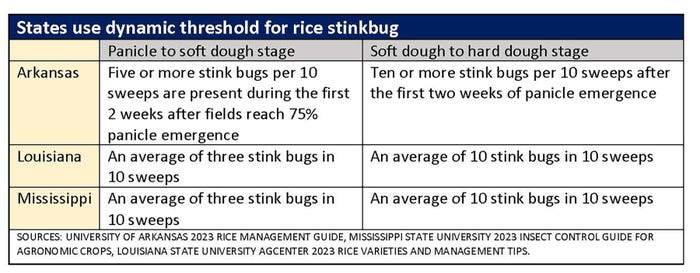
How to manage rice stinkbugs could be written like a children’s book: if you find rice stinkbugs in your field, then you must find a way to treat them. If a pesticide is available, it might not be efficacious. If the pesticide is efficacious, it’s probably not available. If an efficacious pesticide is available, it may not be approved for export. If you rotate your rice fields with crawfish, supply and efficacy don’t matter; you don’t have a labeled pesticide option.
Despite the circular nature of a conversation about managing rice stinkbug, scouts and rice farmers must stay on top of the economically damaging pest.
The first management step, of course, is scouting.
“You’ve got to be diligent and timely with your sampling,” Mississippi State Extension Entomologist Don Cook said. “When the rice starts heading, start looking.”

Each of the Midsouth states uses a dynamic threshold (see table) to decide whether to treat for rice stinkbug.
Stinkbug management
University of Arkansas Extension Entomologist Nick Bateman offers additional guidance in the 2023 Rice Management Guide:
Sampling stink bugs should be conducted between 8 to 10 a.m. or 6 to 8 p.m. to get the best estimate of the population.
Terminate insecticide applications at 60% hard dough or straw-colored kernels.
Though entomologists rarely make any predictions on pressure from any insect in any crop any year, Mississippi State University Extension entomologist Don Cook is willing to step out with two:
Rice stinkbug can reduce rice yield and grain quality. “We have seen a lot of stinkbugs in wheat and ryegrass already,” Cook said. He points out that rice stinkbugs reduce yield when they cause damage between panicle and soft dough; they impact quality when they damage rice older than soft dough.
Pyrethroid resistance will probably be more prevalent. “Our pyrethroid resistance problems are likely going to be worse than they were last year,” Cook said.
To the west, Louisiana State University Extension Entomologist Blake Wilson has two production scenarios: southwest fields where farmers rotate rice with crawfish and fields in the northeast part of the state where row crops dominate the acreage.
“In southwest Louisiana, they haven’t sprayed for stinkbugs in probably 30 years,” Wilson said. “They don’t have any products that are legal to use in a crawfish rotation.”
Wilson said rice farmers in northeast Louisiana face the same struggles as their Mississippi and Arkansas neighbors: pyrethroid resistant rice stinkbug populations and limited treatment options.
“Up there they’re seeing the same trends that they’re seeing in Mississippi and Arkansas: the pyrethroid lambda cyhalothrin has become almost totally ineffective,” Wilson said.
Turn to Tenchu 20SG
With pyrethroid efficacy waning, Midsouth entomologists recommend Tenchu 20SG, the only insecticide available with a Section 3 label for controlling rice stinkbug in rice.
Dinotefuran, the active ingredient in Tenchu 20SG, generally offers longer residual activity on rice stinkbug, Wilson said. In 2022, however, Tenchu 20SG demand outpaced supply.
“I’ve taken some steps to shore up availability of Tenchu,” Wilson said. “This year I’ve tried to work with the industry reps to make sure they have product available.”
Supply issues complicate treatment options.
Mississippi and Arkansas rice farmers may also have access to Endigo. Extension leaders in those two states again applied for a Section 18 for Endigo ZCX on rice stinkbug in rice. The U.S. Environmental Protection Agency granted a Section 18 in 2022 based on supply challenges for other treatment options, Cook said. For 2023, he said, “We hope to hear something by early July.”
Louisiana farmers, however, will not have that option because the state did make a Section 18 application to EPA over concerns about exasperating resistance issues. Endigo ZCX, Wilson points out, is a pre-mix that includes the pyrethroid lambda cyhalothrin. Though thiamethoxam is efficacious, Wilson said, the pyrethroid in the pre-mix adds resistance pressure.
“If you use Endigo ZCX, you’re putting out a product that doesn’t give you any efficacy, and may perpetuate the problem,” Wilson said. “For that reason, I recommend the Tenchu for our growers.”
Stick to labeled products
Prior to 2019, a few barge loads of rice were rejected for export because of acephate contamination. Whether the residue was the result of off-label application of acephate or the insecticide contaminated rice fields when it drifted from nearby soybean fields, the specter haunts the industry. The 2023 University of Arkansas Rice Management Guide provides firm guidance on the issue: “Acephate is not labeled in rice. Use of acephate in rice jeopardizes the whole rice industry.”
All of which sometimes drives rice farmers back to treating their crop with a pyrethroid.
“It’s frustrating to spray a pyrethroid and only get three to four days of control out of it,” Cook said. “In 2022, some producers had to use a pyrethroid because it was the only option. We had to be willing to take 40 to 60% control and tighten up the spray interval.”
About the Author(s)
You May Also Like






